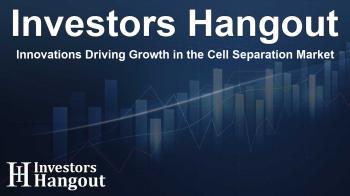Innovations Driving Growth in the Cell Separation Market

Cell Separation Market Overview
The cell separation market is witnessing tremendous growth, projected to soar from USD 9.55 billion in 2023 to USD 30.15 billion by 2032. This represents a remarkable compound annual growth rate (CAGR) of 13.63%. The rising demand for personalized medicine, advancements in biopharmaceutical technologies, and the increasing application in biomolecular isolation are crucial drivers propelling this market forward.
Key Market Trends
Several factors contribute to the robust advancement of the cell separation market. The increasing focus on personalized treatment options and innovative therapies is reshaping healthcare and scientific research. Technologies utilized in cell separation play an essential role in drug discovery, vaccine development, and cell-based therapies, demonstrating their vast potential across various applications.
Technological Innovations
As the industry evolves, traditional technologies remain integral while newer, more sophisticated methods emerge. Centrifugation processes and consumables continue to dominate, making up significant portions of the market share. Innovations such as automation and microfluidics present exciting prospects for enhanced efficiency and simplified workflows in cell isolation.
Investment in Research and Development
The consistent funding from both public and private sectors highlights the critical role of R&D in this market. Companies invest heavily in improving and expanding their capabilities, ensuring that they stay competitive. This ongoing investment drives the continuous introduction of advanced technologies and methodologies.
Regional Market Insights
North America retains its leading position in the cell separation market with a market share of 40.2%. The U.S. market alone is expected to reach USD 8.57 billion by 2032, supported by strong biopharmaceutical infrastructure and substantial research funding. Moreover, the Asia Pacific region emerges as a significant player, exhibiting impressive growth rates due to government investments and an increasing demand for stem cell therapies.
Market Segmentation
The cell separation market is categorized into various segments, reflecting diverse applications:
- By Product: Consumables, including reagents and kits, accounted for over 50% of the market share in 2023. This is attributable to their recurrent need in both research and clinical environments.
- By Cell Type: Animal cells dominated with a 54.5% share, critical for vaccine production and genetic engineering.
- By Cell Source: Adipose tissue led with a 40.2% market share, used extensively in regenerative medicine.
- By Technique: Centrifugation took the lead, claiming 55.1% of the market due to its efficiency in achieving high-purity cell isolation.
- By Application: Biomolecule isolation constituted a 35.8% share, driven by the demand for cell-derived substances in diagnostics and drug development.
- By End-User: Pharmaceutical and biotechnology companies held a dominant share of 48.7%, utilizing cell separation technologies for drug discovery and production.
Major Industry Players
Several key players shape the competitive landscape of the cell separation market:
- Agilent Technologies Inc.
- Akadeum Life Sciences Inc.
- BD (Becton, Dickinson and Company)
- Bio-Rad Laboratories Inc.
- Thermo Fisher Scientific Inc.
- Lonza Group Ltd.
- Merck KGaA
- Miltenyi Biotec
- QIAGEN NV
- Corning Incorporated
Recent Developments
In January 2025, Akadeum showcased their innovative Alerion system at Advanced Therapies Week, which generated significant interest within the industry for enhancing cell isolation methods.
Future Outlook
Looking ahead, the cell separation market is positioned for continuous growth. With the rise of automation, microfluidics, and AI-driven technologies in this field, the future of cell isolation strategies appears bright. The possibilities are vast, with emerging breakthroughs set to transform cell separation methodologies.
Frequently Asked Questions
What is the projected growth rate of the cell separation market?
The market is expected to grow at a CAGR of 13.63%, reaching USD 30.15 billion by 2032.
What factors are driving this market's growth?
Advancements in biopharmaceuticals, demand for personalized medicine, and applications in regenerative medicine are major growth drivers.
Which products dominate the market?
Consumables, particularly reagents and kits, accounted for the largest market share in 2023.
Who are the key players in the cell separation market?
Major companies include Agilent Technologies, BD, Thermo Fisher Scientific, and Bio-Rad Laboratories, among others.
What regions are experiencing the fastest growth?
The Asia Pacific region is currently the fastest-growing market, driven by increasing government investments and demand for stem cell therapies.
About The Author
Contact Addison Perry privately here. Or send an email with ATTN: Addison Perry as the subject to contact@investorshangout.com.
About Investors Hangout
Investors Hangout is a leading online stock forum for financial discussion and learning, offering a wide range of free tools and resources. It draws in traders of all levels, who exchange market knowledge, investigate trading tactics, and keep an eye on industry developments in real time. Featuring financial articles, stock message boards, quotes, charts, company profiles, and live news updates. Through cooperative learning and a wealth of informational resources, it helps users from novices creating their first portfolios to experts honing their techniques. Join Investors Hangout today: https://investorshangout.com/
The content of this article is based on factual, publicly available information and does not represent legal, financial, or investment advice. Investors Hangout does not offer financial advice, and the author is not a licensed financial advisor. Consult a qualified advisor before making any financial or investment decisions based on this article. This article should not be considered advice to purchase, sell, or hold any securities or other investments. If any of the material provided here is inaccurate, please contact us for corrections.

